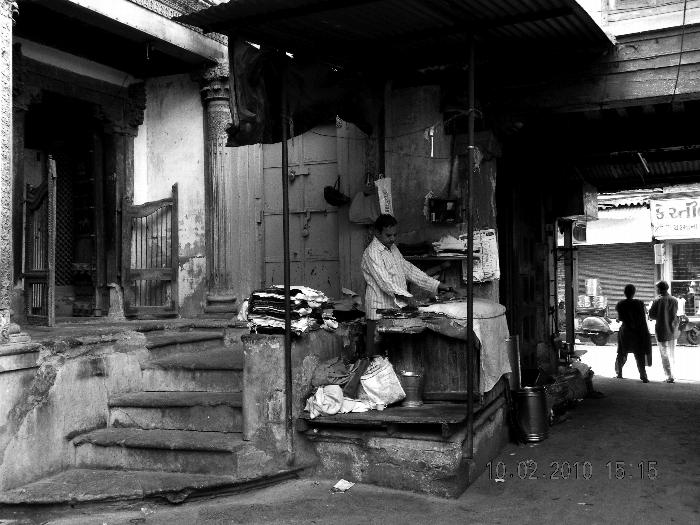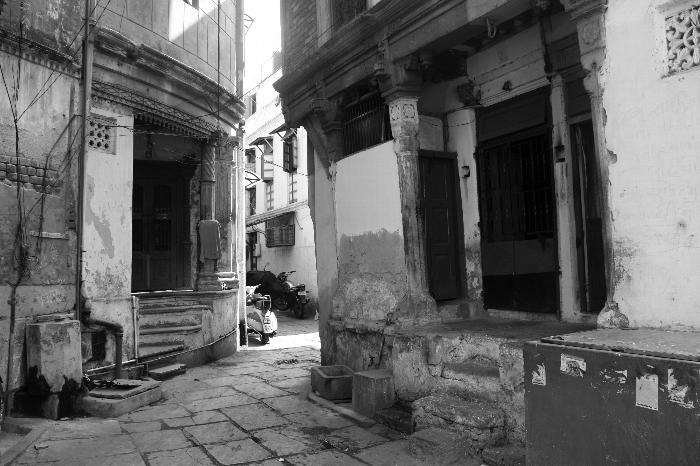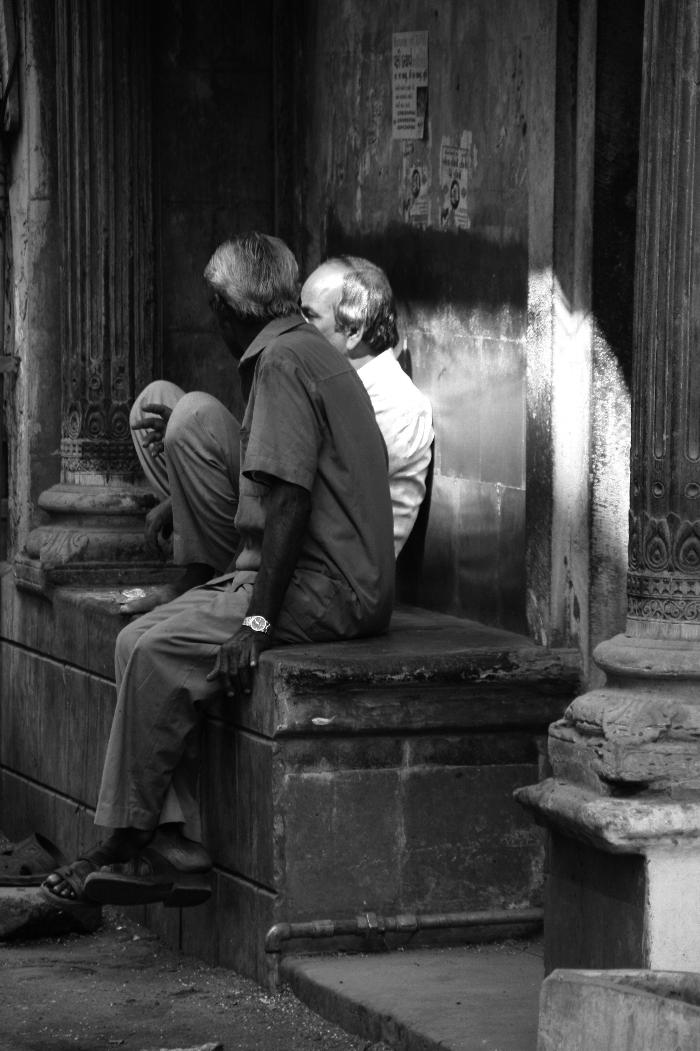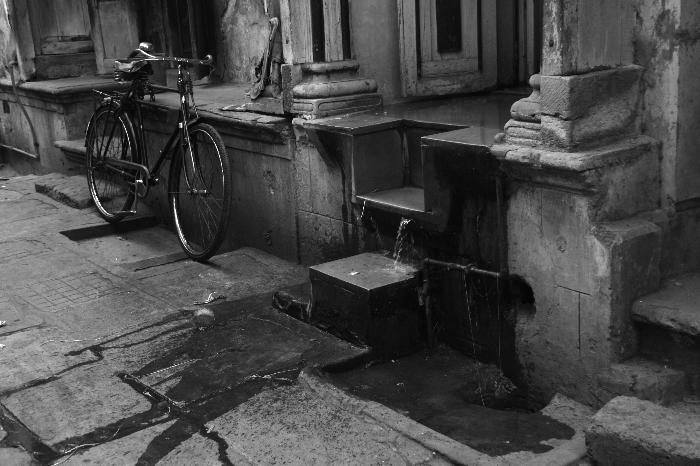[ID:15] Of the House, the City, the Earth and the Universe: The Otla as a Threshold SpaceIndia “The harm begins when we forget that our entrance was only a hole we made in the complete building- or when we lose sight of the fact that our hole does not introduce us into the building but leads us outside it, since the ‘house’ we are considering does not stand ‘over there’, but encompasses us. We are part of it.” R. Pannikkar
This essay seeks to highlight the "otla" as an integral part of the traditional dwellings in the old city of Ahmedabad in the state of Gujarat. The word "otla" derives its roots from the Sanskrit term aasthal, aas (Sanskrit root) means to lie upon, to stay, to live and the sthal refers to space, earth, ground. It is an important element of the communities of dwellings found in walled city, known as "pols". The pols are characterized by the idea of containing its people in a gated neighborhood. The word "pol" comes from its Sanskrit root pratoli, which refers to a locality with a gate or a neighborhood with a broad entrance. Another relevant meaning of the word “pratoli” refers to the pol as the principal street passing through the settlement or the neighborhood.
The otla is the plinth bordering the street and forming the space around the doorway of the house. In principle the otla is the shaping of the ground. Its space is formed by elements that complete it in the vertical and horizontal directions. The wooden columns that rest at its edge support the extension of the floor above, to articulate the verticality of its space. Its horizontal space extends from the wall of the house that encases the intricately carved doorframe across the street to the opposite otla and the wall of the opposite house.
The construction of the otla is typically in stone. The stone flooring extends beyond the wall of the plinth to articulate its edge in order to establish the horizontal plane while retaining the feel of being an element moulded from earth. Steps carry the street upwards to the otla and then inside the house, gradually reducing the momentum of movement to the pace and character of domestic living. They give a sense of arrival into the realm of the house yet not a complete departure from the life of the street. They keep the house and the street in continual conversation.
Conversation is an important part of the culture of Ahmedabad. People prefer to spend their time sitting outdoors to strengthen their sense of connection with the community. The otla is an important element that has built the community life and culture of the city - it has acquired a special place in the minds of people of this city. In the absence of the otla, people find refuge in other spaces that tender similarity of experience of being connected to the community.
The otla as a threshold space:
The street is the container of activity in the pols. The otla adds a layer of porous space to the street giving its edge a thickness. It is a transitional space where the dwellings open on to the street and the street gradually moves into the dwellings. It provides a platform for a dialogue between the inside and the outside.
The otla is built as an architectural element holding the space of the house and the street in constant flux. While considering the house and the street as the two polarities of space, we encounter the dichotomies of private and public, inner and outer and the conceptual and the real. In the Indian philosophical framework, space is constituted in the relationship between the inner and the outer space. It is not a simple addition of the inner and outer space, neither can it be simply divided into inner and outer.
The otla not only forms a threshold between the inside and the outside, it stands in space and holds a space within it. The Chandogya Upanisad states, “There is no outer without inner space. Space is as much the container of ‘things’ as much as it is contained within them.” It goes on to say that “All is within it”. The otla positions itself precariously in this context; it demarcates the ending/closure of one space and the beginning/opening of another, yet it is not a hard lined distinction between the two, but a supple carrier of both the inside and the outside.
These conceptual notions of space concretize into the form of the otla as a threshold. The otla makes itself as much part of the landscape, that it itself is shaping. Since the landscape man dwells in, moulds his inner space as much as he moulds the landscape as a reflection of his inner space. Juhani Pallasma in his book The Thinking Hand elaborates the concept of human landscape; “In this sense, the art form of architecture does not only provide a shelter for the body, it also redefines the contour of the consciousness and it is a true externalization of our mind. Architecture, as well as the entire world constructed by man and its cities, houses, tools and objects, has its mental ground and counterpart. As we construct our self-made world, we construct projections and metaphors of our own mindscapes. We dwell in the landscape and the landscape dwells in us.”
The making of the otla is a conscious act of responding to the local topography, street patterns, community space, and movement of the sun and the wind. Social and cultural subtleties are embedded in its form. The otla occurs as a transitional space between the house and the street, inside and outside, public and private, between neighbors and finally between the conceptual and the real. These negotiations are a result of the territorial nature of man, an intrinsic characteristic rather than the hard lined concept of property. It comes into being through the negotiation between these entities. Therefore, it is not a remainder of either. It is in fact the ordering principle that structures both the house and the street. The community respects this space since it belongs to an individual and at the same time to the community as a whole.
The otla in its inhabitation:
Even an extremely vivid spatial account of this architectural element cannot give us a feel of its being since its essence is in its inhabitation. It is not only physical space occupied by people, it also occupies their mental space. The otla dwells within the people of this culture, so much so that it cannot be severed from their inner space.
The otla is inhabited with conversations of various kinds throughout the day. The sound that is created by the constant movement of people through the street becomes part of its experience. Each time a vendor selling fruits or flowers passes the street the otla is filled with their fragrance - carried by the breeze that flows through. While inhabiting the otla our senses are in constant conversation with the environment, natural and built. The experience of occupying the otla revitalizes our senses, making them receptive to these subtleties. We feel connected to the ground and the sky and to society at large.
Time, Ritual and Cosmos:
The Bhagavat Purana speaks of the threshold in the following myth: “Hiranyakashipu was granted a boon by Brahma (God of all creation) that his death never be brought about by any weapon, human or animal, be it inside his residence or outside, neither at daytime nor at night, not by a human, demigod or demon, neither in the sky nor on earth. Hiranyakashipus son Prahlad was a devoted follower of Vishnu. This aggravated him to such a degree that he wanted to terminate Prahlad’s life. In order to cease his acts Vishnu (preserver of the cosmos) assumed the form of Narsimha, half man-half beast, at twilight to slay the king on his thighs at the threshold of his house, using only his fingernails to disembowel and kill him.”
The otla exists within varied contexts and concepts of space, and space cannot be separated from time. The nature and role of the otla change with time. Time as a linear entity, as a record in history, is an aberration of the cosmos in modern society. Time in primitive societies has always been cyclic. Mircea Eliade in his book The Myth of the Eternal Return elaborates the concepts of time in primeval societies (as well as in modern eastern societies) as being cyclic, its cyclic nature implying that there is a constant regeneration of time through ritual acts. The periodicity of time is marked by rituals that enact the ending of one period of time and the beginning of another. In this process they perform the entire cosmogonic act, the act of creation of the universe. As the ritual progresses it demonstrates the degradation of the world into primordial chaos, when time is suspended and all order destroyed. All is dissolved into the waters of non-existence. The act that follows is an act of emergence, the emergence of an order from the primordial chaos as a creation of the cosmos all over again. This is the sequence of events that elaborate the transitions in time. What is important here is crossing over the threshold from one time cycle into another.
This cyclic repetition is experienced at the diurnal scale, when each day and night return one after the other in continuity. This continuity makes everyday actions ritualistic. The actions at the beginning of the day and at the end of it become more significant as rituals than functions, by ending each day in a particular way to begin the next. The enactment of these rituals requires the space to be remade each time the cycle begins and correspondingly terminate it at the end of each cycle. The space that is most important to the house - the otla, is reconstructed everyday as part of the ritual act.
The threshold relates to the movement of the earth between night and day. It gives way to the ritual act of remaking the otla. The day begins with a familiarization of the house with the street, the news from the papers and passerby alike, along with the regular cup of tea. The household activities spill over to this space, the old find comfort in the happenings of the street and the children find other children to re-live their imaginary world from where they left it the day before. Housewives gossip across the street about mother-in-laws, other housewives and respective husbands while carrying out household activities. The otla becomes a platform for the interactions of households during the course of the day, as the streets become busier and more bustling with activity, allowing the households to open out to the activities of the street. The space is full and dense by the evening.
The evening is the most critical time, as it lies between the threshold of the day and the night, not belonging to either. By twilight things begin to subside. The neighborhood becomes private again. Each otla is washed, cleansing the threshold of the residues of the day and washing-off evil…an oil lamp is lit accompanied by a rangoli (cosmic patterns made with rice flour on the floor). The space is made to connect to the cosmos and primordial time. When night prevails the space of the otla is destroyed, metaphorically of course, to being lifeless, formless only to be recreated by the following morning rituals of making.
Revival of the otla- bringing back the threshold:
The modern world has become a world of distinctions rather than that of continuity and synthesis. Space has been cut into many different categories destroying its wholeness and cohesiveness. The ambiguity of space existing at the threshold of two spaces has been misplaced. The manner of behavior has become rigid, responding to protocols of either being in one category or another.
The city of Ahmedabad and its people are at the threshold of the old and the new. The city has grown over the last six centuries and is spreading continuously. Its population is now five million and it faces an immense shortage of quality habitation. New forms of habitation have emerged in the city constrained more by the economics than socio-cultural patterns. We accept the newer gated communities with much skepticism, since they lack the elements such as the pol gate and the otla. The gates in of these dwellings are more closed than open, and space is understood as a set of distinctions. Modern day housings struggle to keep the scale of dwellings humane. The materials and processes of construction have undergone tremendous change. With what premise then does one talk about the conservation of the otla? Should or can the otla be preserved as a mere element of the pol house? Can it remain and function in its originally conceived form or will it have to adapt to modern situations? Is it not a matter of grave concern that the people are devoid of a space like the otla?
It is important to understand that an otla of equal value can be conceived in a modern housing, since what is to be conserved and preserved is not the otla as that particular element of the dwelling in the walled city but as an element that beholds the complex nature of socio-cultural relationships. The otla exudes that a house is not a machine to live in, that a house is not provided fully from the inside but holds equal life around it as there are varying intensities of public and private life to be enjoyed. It sequences the movement from the busy street, gradually slowing it down to the pace and character of the dwelling. Yet it is not like a porch, which in its function is a mere passage of movement. The otla by itself is a space of dwelling. It facilitates a measured increase in scales as one moves from the insides of the house onto the street, keeping the dimensions taut for a comfortable space to be formed for socialization. This would also require that houses do not stand as individual buildings in space but form a cluster of communities. An individual or a group can only value space when it has a sense of ownership attached to it- when one truly inhabits the space. The space of the otla will have to be held sacred by the individual and the community for its propagation as an essential space for dwelling. What is to be preserved is the character and value of the otla that has been forgotten in the modern age.
Bibliography: 1. Pannikkar, Raimundo. "There is no Outer without Inner Space". Concepts of Space: Ancient and Modern, South Asia Books, 1991 2. Eliade Mircea. "The Myth of the Eternal Return", Bollingen, 1971 3. Pallasma, Juhani. "The Thinking Hand", John Wiley and sons, 2009
If you would like to contact this author, please send a request to info@berkeleyprize.org. |




